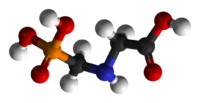
Photo from wikipedia
ABSTRACT Amino acids are important components of the soil organic nitrogen pool. There is, however, a current lack of knowledge concerning how exogenous C and N regulate amino acid uptake… Click to show full abstract
ABSTRACT Amino acids are important components of the soil organic nitrogen pool. There is, however, a current lack of knowledge concerning how exogenous C and N regulate amino acid uptake in the soil microorganism/plant system. We used a 13C,15N-glycine injection method to examine glycine-derived 13C and 15N partitioning in a planted or unplanted spring wheat pot experiment. Four treatments were used: control (CK), ammonium sulfate (N), glucose (C), and ammonium sulfate with glucose (NC). The results showed that amino acids were absorbed intact by soil microorganisms and plants at 4 h. An exogenous excess of C, rather than N, resulted in a reduced uptake of intact glycine by soil microorganisms, indicating that glycine was taken up primarily to fulfill their C requirement. Wheat was more effective in competing for glycine-C and N at 24 h. 13C and 15N partitioning in wheat was significantly influenced by exogenous C and N availability; uptake of 13C and 15N by wheat increased with increasing C and N availability. We concluded that amino acids are important not only for N but also for C to soil microorganisms and plants, which are able to respond quickly to exogenous C and N source application.
Journal Title: Archives of Agronomy and Soil Science
Year Published: 2020
Link to full text (if available)
Share on Social Media: Sign Up to like & get
recommendations!